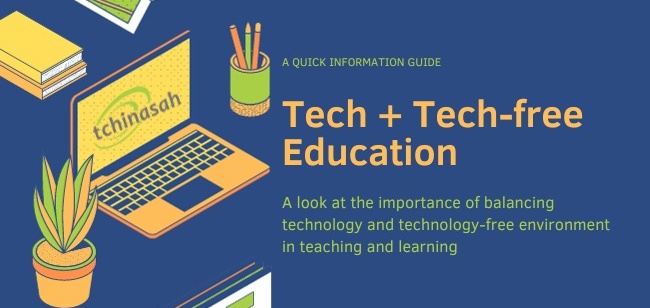In a world dominated by screens, apps, and electronic devices, today's students are immersed in technology like never before. While there is no doubt that technology provides significant educational benefits, it is also critical to understand the value of tech-free experiences in supporting holistic development. The issue for teachers who are dealing with this contradiction is finding the right balance. Here's a guide to assist teachers in navigating this difficult terrain.
Benefits of Tech Integration for Your Students
The use of technology in the classroom can provide various advantages. Here are five important benefits of technology integration for students:
- Increased Engagement: Technology often offers interactive platforms and multimedia tools that can enhance learning. Videos, animations, and interactive simulations can capture students' attention while also making abstract or complex ideas more understandable and relatable.
- Access to a Wide Range of Resources: The internet is a massive repository of information. Students can use technology to access a wealth of materials, such as e-books, academic publications, video lessons, and more. This allows students to explore things in depth and from multiple points of view, resulting in a more comprehensive understanding.
- Opportunities for Collaborative Learning: Online tools and platforms enable students to collaborate in real-time, irrespective of geographical constraints. Tools such as Google Docs, online discussion forums, and educational apps enable students to collaborate on group projects, share insights, and engage in peer-to-peer learning, fostering teamwork and a broader perspective.
- Personalized Learning Paths: Adaptive learning technology can give customized educational experiences that are adapted to the learning pace and style of each learner. Platforms that customize content based on a student's performance can aid in identifying areas of strength and weakness, allowing teachers to effectively meet individual needs.
- Computer Skills Development: As the world gets more digital, having computer skills is key. Students not only learn the curriculum but also build digital literacy when technology is used in the classroom. Understanding how to use various technologies, practicing safe online habits, and developing critical thinking skills to evaluate the large quantity of information available online are all part of this process.
Integrating technologies effectively demands a careful approach to ensure that it enhances rather than distracts learning. When done appropriately, technology integration can undeniably improve students' educational experiences.
Benefits of Technology-Free Experiences for Your Students
While technology offers numerous advantages, tech-free experiences are as important for complete development. Here are five benefits of incorporating technology-free experiences for students:
- Encouraging Deep focus and Reflection: In an age of frequent notifications and digital distractions, tech-free experiences allow students to delve deeper into subjects, fostering longer attention spans and improved focus. This atmosphere promotes reflection, analytical thinking, and knowledge absorption without regular digital distractions.
- Fostering Social and Emotional Intelligence: Without the distraction of devices, face-to-face interactions allow students to learn critical life skills such as empathy, active listening, and effective verbal communication. They learn to interpret nonverbal clues, understand emotions, and make genuine human connections, all of which are important for emotional well-being.
- Physical Wellness: Activities that demand movement, such as a field trip, hands-on experiments, or sports, are common in tech-free experiences. Such activities promote physical health and reduce hazards such as obesity and posture-related concerns by minimizing sedentary behavior linked with prolonged screen usage.
- Improving Sensory Experiences: Real-world, hands-on activities create a multimodal experience that screens cannot mimic. Whether it's a science experiment, an art project, or reading a physical book, these encounters engage different senses, resulting in improved retention and understanding.
- Reducing Digital Fatigue and Promoting Mental Health: Constant screen exposure can cause digital or visual weariness. Taking breaks from technology allows pupils to mentally rejuvenate. Furthermore, real-world contacts and activities can alleviate feelings of isolation or anxiety caused by excessive digital intake, thereby improving general mental health.
While it is undeniable that we live in an increasingly digital age, the value of in-person, tech-free experiences has not lessened. A mix of digital integration and tech-free activities is crucial for pupils to develop into well-rounded persons.
Practical Tips for Teachers on Balancing Both Worlds
It is critical to balance technology with non-tech activities in order to ensure a complete educational environment. Here are five practical ways teachers might achieve this balance:
- Scheduled Tech Breaks: Set aside particular hours during the day for non-technological activity. For example, following a session incorporating digital tools with a talk, group exercise, or hands-on experiment that does not require screens. Students can enjoy the best of both worlds by arranging the day with periods of digital usage and non-use.
- Project-Based Learning: Incorporate projects that need both online and offline study and execution. Students, for example, can conduct internet research on a topic, but the presentation or model they develop must be physical. This encourages them to use technology to gather information while also emphasizing the importance of tactile interactions.
- Tech-Free Zones: Set apart portions of the classroom or school where technology is not permitted. These zones, whether they be a reading nook, an art area, or a discussion circle, can allow students to communicate, collaborate, and learn without having to make use of digital devices.
- Encourage Offline Social Activities: Host events or activities that encourage face-to-face interaction such as debates, role-playing, group discussions, or outdoor games. This not only improves students' social skills but also allows them to collaborate and learn from each other in a non-technological environment.
- Digital Awareness and Etiquette Workshops: Educate students on the advantages and disadvantages of technology. Organize workshops to explore the benefits of technology-free time, the perils of excessive screen time, and the value of interpersonal skills. When students understand why it is important to balance tech and non-tech experiences, they become more inclined to value and embrace both.
Teachers play a key role in modeling and setting the tone for responsible technology use. Teachers can ensure that students are prepared for the future while being anchored in the present by smoothly integrating both digital and real-world experiences into their education.
In conclusion, while the digital age provides unprecedented learning opportunities, it is critical not to forget the human aspects of education. Teachers may provide a rich, diversified, and balanced learning environment that responds to the multiple requirements of today's students by integrating tech and tech-free experiences. We train students not only for the digital future, but also for a meaningful, connected, and complete life.












Comments